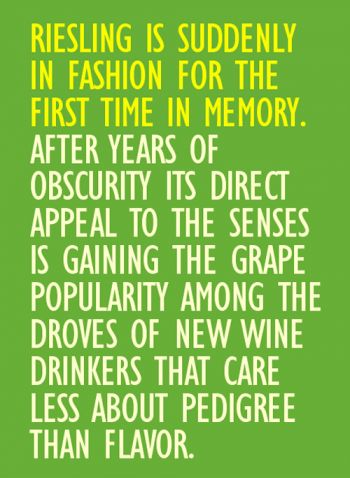Rieslings!
One
of the reasons Riesling appeals to us so much more
immediately than many other varieties is that it’s not an
acquired taste: you don’t have to search for flavor
undertones and subtleties. At the same time they are often
present, so the grape also has the potential to excite more
experienced palates as well. The reality is that Riesling is
among the most transparent of white grapes showing off with
precision in its aromas and flavors even minute effects of
soil and climate. Every vineyard has the potential to
produce a demonstrably different wine (some with
demonstrably earthy and mineral-like scents), as does every
vintage. In this way the grape is much like Pinot Noir. It
also parallels Pinot in the sense that it’s fussy about
where it should be grown, requiring a very cool climate and
long even ripening cycle to show its best. In fact, if
there’s another Hollywood movie made featuring a
trend-setting but moody grape variety, it’s a good bet it
will be Riesling.
The number one
myth about Riesling is that it’s sweet. In fact, this is
among the most versatile of white grape varieties, capable
of producing wine in a bone dry, medium dry, medium sweet,
and very sweet style. The decision is the winemaker’s. As
the French say: vive la difference! But herein lies a
problem and an obstacle to even greater consumer acceptance.
Unless it’s a German Riesling and you know how to read the
very precise label information you’re looking at, odds are
you end up getting a different type of wine than you were
bargaining for. In other words, if you’re interested in a
wine with some sweetness and you buy a bone-dry wine
instead, you’re not likely to be satisfied. The reverse is
obviously true as well. Not that there is anything wrong
with sweetness in a wine – other than the fact that some
people fear appearing unsophisticated if they’re caught
drinking a wine that has noticeable quantities of sugar –
but as a consumer you should know beforehand so you can plan
what you’re going to eat with it accordingly. Or at least
that’s the popular conception. Personally, a Riesling’s
sugar or lack thereof doesn’t faze me because of the vibrant
acid the grape usually displays. If a well balanced wine is
too sweet for a particular dish or occasion I will just
chill it more; if it’s a bit dry for the circumstances I’ll
usually serve it closer to room temperature, which
emphasizes whatever sugar is present and pumps up the flavor
a bit. What all good Rieslings, from dry to very sweet,
should have is a lot of fruit flavor. This is usually the
component that will determine how well they match with
different food. And with Riesling the range of fruit you
will taste is bounteous: from lemon occasionally to every
type of apple, pear, apricot, and peach, to more tropical
sensations of pineapple, mango and passion fruit. One of the
great things about Riesling too is you often get all this at
a reasonable price. These are wonderful wines to promote
because they pack maximum flavor and are easy to drink but
in general you are able to keep the tab to less than $2O per
bottle. The following favorites all fall into that price
range. They’re organized roughly from driest to sweetest and
each was tasted in a blind context over the past few
months.
|
Kuentz Gisselbrecht, McWilliams Brancott, Annie’s Covey G.A. |

